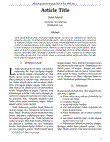Search Results - "North America"
Suggested Topics within your search.
Suggested Topics within your search.
- Acero 1
- América Septentrional 1
- América del Norte 1
- Autonomy; indigenous liberation; self-government; North America; native organizations 1
- Autonomía; liberación indígena; autogobierno; Norteamérica; organizaciones nativas 1
- C65 1
- C67 1
- Chiroptera 1
- Customs 1
- Economics Networks 1
- Graph Theory 1
- Input –output model 1
- Latin America 1
- Latinoamérica 1
- Leyes de Townshend; Ley del Té; impuestos; rebelión; identidad nacional 1
- Modelo de Insumo-Producto 1
- Monarquía Hispánica 1
- Nación pisona 1
- North America 1
- O51 1
- O54 1
- Pisones 1
- Pseudogymnoascus destructans 1
- R15 1
- Redes económicas 1
- Teoría de gráficas 1
- Townshend's Laws; Tea Law; taxes; rebellion; National identity 1
- Tradescantia spathacea 1
- aduana 1
- communication policies 1
-
21
-
22
Listado florístico de especies anuales de floración invernal en el noreste de Nuevo León, México
Published 2013“…Eleven species (15%) are considered invasive or noxious weeds in some part of North America. Although many of the species are ruderals, the total group is varied and its biological and ecological importance as a part of the native vegetation is unknown. …”
Get full text
Article -
23
Listado florístico de especies anuales de floración invernal en el noreste de Nuevo León, México
Published 2013“…Eleven species (15%) are considered invasive or noxious weeds in some part of North America. Although many of the species are ruderals, the total group is varied and its biological and ecological importance as a part of the native vegetation is unknown. …”
Get full text
Article -
24
Cooled Radiofrequency Ablation in Shoulder Pain: A Cohort study
Published 2025Get full text
Article -
25
-
26
-
27
Economia Política do Cinema mexicano: fonte e consumo de películas nacionais em Monterrey, México (2001-2010) = Economía Política del Cine mexicano: oferta y consumo de películas n...
Published 2012“…ABSTRACT: The objective of this study is to analyze the implications that the adoption of the neoliberal economic policies like the opening of the markets, the deregulations and privatizations of the industry, from the company/signature of the Free Trade Agreement of North America (TLCAN), they have had in the Mexican cinematographic industry. …”
Get full text
Article -
28
A new species of Trachymyrmex (Hymenoptera, Formicidae) fungus-growing ant from the Sierra Madre Oriental of northeastern Mexico
Published 2017“…The divergence of the lineages of T. pakawa and T. smithi could have been driven by the Pliocene-Holocene desertification of southwestern North America. This process resulted in isolated mesic refugia and forests in the Madrean ranges and piedmonts of northeastern Mexico (the current habitat of T. pakawa) while T. smithi adapted to the deeper, often sandy soils on the drier desert plains of Coahuila and Chihuahua states in Mexico, and New Mexico and Texas in the USA. …”
Get full text
Article -
29
A new species of Trachymyrmex (Hymenoptera, Formicidae) fungus-growing ant from the Sierra Madre Oriental of northeastern Mexico
Published 2017“…The divergence of the lineages of T. pakawa and T. smithi could have been driven by the Pliocene-Holocene desertification of southwestern North America. This process resulted in isolated mesic refugia and forests in the Madrean ranges and piedmonts of northeastern Mexico (the current habitat of T. pakawa) while T. smithi adapted to the deeper, often sandy soils on the drier desert plains of Coahuila and Chihuahua states in Mexico, and New Mexico and Texas in the USA. …”
Get full text
Article -
30
Winter diet of the long-eared owl Asio otus (Strigiformes: Strigidae) in the grasslands of Janos, Chihuahua, Mexico
Published 2017“…Abstract Background: The long-eared owl (Asio otus) has a Holarctic distribution, including much of North America. This nocturnal species is considered to be extremely secretive, and poorly known in the Great Plains of the United States and Canada, as well as to México, where no previous studies on its diet have been conducted. …”
Get full text
Article -
31
Paleoclimatic modeling and phylogeography of least killifish, Heterandria formosa: insights into Pleistocene expansion-contraction dynamics and evolutionary history of North Americ...
Published 2013“…Our findings bolster growing appreciation for the complexity of phylogeographical structuring within North America’s southern refugia, including responses of Coastal Plain freshwater biota to Pleistocene climatic fluctuations.…”
Get full text
Article -
32
Multicenter, International Study of MIC/MEC Distributions for Definition of Epidemiological Cutoff Values for Sporothrix Species Identified by Molecular Methods
Published 2017“…Data were obtained in 17 independent laboratories (Australia, Europe, India, South Africa, and South and North America) using conidial inoculum suspensions and 48 to 72 h of incubation at 35°C. …”
Get full text
Article -
33
Posaconazole MIC Distributions for Aspergillus fumigatus Species Complex by Four Methods: Impact of cyp51A Mutations on Estimation of Epidemiological Cutoff Values
Published 2018“…Posaconazole MIC distributions for the Aspergillus fumigatus species complex were collected from 26 laboratories (in Australia, Canada, Europe, India, South and North America, and Taiwan) and published studies. Distributions that fulfilled CLSI criteria were pooled and ECVs were estimated. …”
Get full text
Article -
34
White-nose syndrome: : An emerging disease and a potential threat to mexican bats
Published 2025Get full text
Article -
35
Estimación de la densidad poblacional de oso negro (Ursus americanus) en el Parque Nacional Cumbres de Monterrey, a través del análisis de ADN.
Published 2017“…ABSTRACT Black bear (Ursus americanus) population densities in North America have been reported to range between 0.02 and up to 0.62 bears per squared kilometer (km2). …”
Get full text
Tesis -
36
Estimación de la densidad poblacional de oso negro (Ursus americanus) en el Parque Nacional Cumbres de Monterrey, a través del análisis de ADN.
Published 2017“…ABSTRACT Black bear (Ursus americanus) population densities in North America have been reported to range between 0.02 and up to 0.62 bears per squared kilometer (km2). …”
Get full text
Tesis


